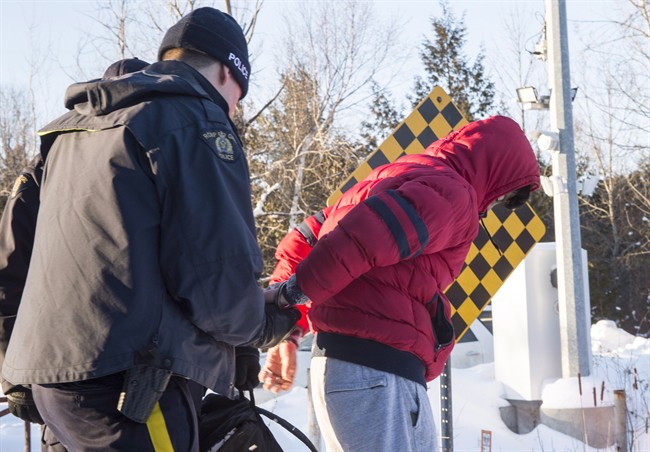New government figures show that while the number of refugee claims may fluctuate from year to year along Canada’s land borders, the winter of 2017 has indeed proven exceptional as hundreds of asylum seekers make their way north on foot.

The number of people crossing into Canada by land and making asylum claims increased more than six-fold in Quebec for the month of February, as compared to the same month last year. In 2016, the Canada Border Services Agency confirmed, 98 people crossed at a land port of entry in Quebec and made a request for asylum. In February 2017, it jumped to 635.
READ MORE: Are asylum seekers ‘queue jumping’ and other key questions
The increase was also fairly dramatic in the Prairies, where attention has been focused on the town of Emerson, Manitoba, and the asylum seekers crossing in brutal winter conditions. In February 2016, there were 27 claims across all the Prairie provinces. For the month of February 2017, Ottawa says the number quadrupled to 110.
WATCH: Emerson fire chief breaks down morning call to rescue 17 asylum seekers

The Pacific region, including British Columbia, has witnessed the smallest increase between the two months. There were 22 claims in February 2017, according to the government, compared to 14 a year earlier.
These numbers include asylum seekers who cross illegally, are arrested by the RCMP and then brought to a designated border crossing to be processed. They also include the people who cross legally at a border check-point and then make a claim.
“These statistics do not include asylum claims made at inland CBSA offices or at Immigration, Refugees and Citizenship Canada (IRCC) offices,” said CBSA spokesperson Nicholas Dorion in an email.
“Figures may vary slightly depending on the date when the claim was received and processed in our databases.”
Both the CBSA and the immigration department have taken pains to point out that the number of people who seek asylum in Canada can fluctuate dramatically from year to year. In 2001, for example, there were just over 44,600 claims made across the country, including at the border and in-land. In 2013, it was a little more than 10,300.
READ MORE: Ottawa weighing chances of potential surge in U.S. asylum seekers as weather improves
But the way in which people are crossing this winter, on foot and away from legal check-points, has triggered alarm bells, both from refugee advocates concerned about their safety in the frigid Canadian winter and from government critics who say Canada’s border security is being compromised.
Asylum seekers making the journey this way are taking advantage of a loophole in the Safe Third Country Agreement with the United States. The agreement, which the Canadian government has said will remain in place, requires that people be turned back to seek asylum in America if they cross into Canada at a legal port of entry.
If they cross away from a border check point and are arrested, however, they can then make a claim here.
John Kelly comes to Ottawa
The subject of asylum seekers crossing away from legal checkpoints is expected to be high on the list of priorities for discussion this Friday as U.S. Homeland Security Secretary John Kelly pay a visit to Ottawa.
It’s the first official visit by a member of the Trump administration.
WATCH: President Trump’s new travel ban – what’s changed?

Public Safety Minister Ralph Goodale confirmed on Wednesday that he’ll want to talk to Kelly in detail about the border, and that the two will need to establish a “common fact base” detailing who the asylum seekers are, how they are making the migration north and why, and how the situation might change and evolve in the weeks ahead.
“That blizzard in Manitoba and Saskatchewan the last two nights has been pretty nasty stuff, and I think some attention needs to be paid to how people would actually expose themselves to that kind of physical danger,” Goodale told reporters.
“If you’ve ever been in a Prairie blizzard, you know that is very, very risky. So one question that (we) would have is who organized this, this movement, and did they actually contemplate letting people out on a roadside in the middle of a Prairie blizzard?”




Comments